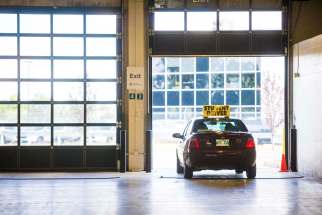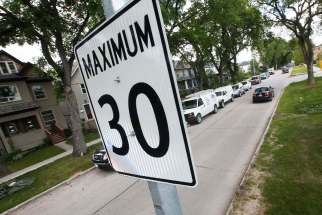Slower speeds catch on quickly
Read this article for free:
or
Already have an account? Log in here »
To continue reading, please subscribe:
Monthly Digital Subscription
$0 for the first 4 weeks*
- Enjoy unlimited reading on winnipegfreepress.com
- Read the E-Edition, our digital replica newspaper
- Access News Break, our award-winning app
- Play interactive puzzles
*No charge for 4 weeks then price increases to the regular rate of $19.00 plus GST every four weeks. Offer available to new and qualified returning subscribers only. Cancel any time.
Monthly Digital Subscription
$4.75/week*
- Enjoy unlimited reading on winnipegfreepress.com
- Read the E-Edition, our digital replica newspaper
- Access News Break, our award-winning app
- Play interactive puzzles
*Billed as $19 plus GST every four weeks. Cancel any time.
To continue reading, please subscribe:
Add Free Press access to your Brandon Sun subscription for only an additional
$1 for the first 4 weeks*
*Your next subscription payment will increase by $1.00 and you will be charged $16.99 plus GST for four weeks. After four weeks, your payment will increase to $23.99 plus GST every four weeks.
Read unlimited articles for free today:
or
Already have an account? Log in here »
Hey there, time traveller!
This article was published 29/07/2020 (1959 days ago), so information in it may no longer be current.
A surefire way to spark spirited conversation among Winnipeggers is to mention 30 km/h speed limits. There are heartfelt arguments for and against such restrictions, but one fact is inarguable: drivers had better get used to the idea, because Winnipeg is part of a national trend of cities forcing drivers to ease up on the accelerator.
A campaign to reduce the residential speed limit will close a section of Ellen Street from noon to 8 p.m. Thursday as residents make their point by using open pavement for fun activities.
Slow speed ahead — campaign touts benefits of 30 km/h zone
Posted:
A campaign to reduce Winnipeg’s residential speed limit will shut down a section of Ellen Street to help others see its vision for “shared” roads.
This follows the approval by city council last week of a one-year pilot project to test a 30 km/h limit on sections of five residential streets: Roch Street, Eugenie Avenue, Warsaw Avenue/Fleet Avenue, Machray Avenue and Flora Avenue.
What’s more — and what’s bound to be even more controversial — is council’s consideration of lowering speed limits on all residential roads. They plan to hire a consultant to study the impact of both 30 km/h and 40 km/h limits throughout the city.
Such changes would extend the 30 km/h school zones that already exist during the academic year. The reduced-speed zones have been a consistent target of public complaint from some drivers, particularly those hit in the wallet by the photo enforcement contractors set up near schools.
People who support lower speed limits — they include cyclists, pedestrians and parents of children — point to evidence that speed kills: pedestrians almost always die when hit by vehicles going 70 km/h, but 90 per cent of pedestrians survive after being hit by vehicles going 30 km/h.
People who oppose lower limits insist vehicular traffic in some areas of Winnipeg is already clogged enough without making it worse with snail-like limits. Many of them suspect the city’s motivation for expanding 30 km/h zones is less about safety and more about a lucrative source of revenue from ticket fines.
This polarizing disagreement is echoed in other Canadian cities that are also on the road to slowing down drivers. Toronto has reduced speeds on almost 50 streets, on arterial roads from 60 km/h to 50 km/h. It also introduced about 50 automated speed cameras to ticket drivers.
Edmonton city council introduced a bylaw last month to decrease the citywide default residential speed limit from 50 km/h to 40 km/h.
Hamilton is in the process of cutting the limit in residential neighbourhoods from 50 km/h to 40 km/h, and to 30 km/h in school zones.
Vancouver is extending the enforcement period of its 30 km/h limit for schools around the clock, and testing the 30 km/h limit in areas without schools or playgrounds.
The Canadian initiatives are variations of a concept called Vision Zero, which started in Sweden more than 20 years ago and has spread to Australia, England and cities, including Oslo, New York, Minneapolis and San Francisco. The goal is to eliminate 100 per cent of traffic fatalities and severe injuries. This is accomplished by rejigging traffic flow, enforcing road rules and educating drivers to respect an unequivocal tenet: pedestrians are paramount.
Winnipeg drivers will have the opportunity in September to display their belief that pedestrians are paramount, especially young pedestrians. School buses will be sparsely occupied because of COVID-19 restrictions, which means an unusually large number of children and youth will be walking, pedalling, blading and skateboarding from their homes to their schools.
If the threat of speed-limit fines is insufficient incentive to slow drivers, the safety of little lives should be.









